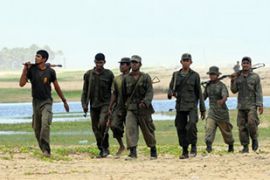Thousands flee Sri Lanka war zone
Reported flight of 2,500 people from the northeast follows fall of rebel sea base.

Thousands of civilians – said by aid agencies, the government and a growing list of nations to be held in the war zone by the LTTE – are under grave threat of harm from the fighting.
A top health official in the war zone, known as Vanni, said last week that 300 civilians had been killed. The UN said at least 52 civilians were killed on Tuesday.
Human shields
Sri Lanka’s military insists it is not targetting civilians, and accuses the Tamil Tiger rebels of using them as human shields.
On Thursday, Mahinda Rajapaksa, Sri Lanka’s president, assured Ban Ki-moon, the UN secretary-general, that the offensive “would be carried out without harassment to the civilian population”, said a statement from the president’s office.
The United Nations, has meanwhile, warned of a food crisis in Sri Lanka’s north.
Emilia Casella, a spokeswoman for the World Food Programme, told reporters in Geneva on Friday that the entire population of Vanni was facing a food crisis.
Some 250,000 people there are completely dependent on humanitarian aid, but the WFP has not been able to get a supply convoy into the conflict zone since January 16, she said.
A convoy that was supposed to enter during a four-hour “humanitarian window” on Thursday could not go because the agency did not receive the necessary clearance from government officials.
It will have to wait until next Thursday, she said.
“We don’t have any more stocks to be distributed, and our staff are essentially hiding at the moment,” Casella said.
International appeals
The US, Britain, the European Union and other major powers have urged the LTTE to surrender, and for both sides to stop firing temporarily to allow civilians out and aid in.
However, Sri Lanka’s government has rejected a call by international donors for it to begin negotiating with the LTTE.
| Focus: Sri Lanka | ||||||||

|
Damien Kingsbury, a professor at Australia’s Deakin University and an expert on Sri Lanka, told Al Jazeera that the LTTE is not going to accept unconditional surrender.
“Quite clearly they fear that if they do surrender, they will be treated very badly if not killed on the spot,” he said.
“The options of a peace deal at this stage look very slim. The government really needs to offer a genuine autonomy package or at least begin to talk about it in conjunction with the ceasefire.
“That doesn’t appear to be on the table at this time.”
Kingsbury said: “Tamil civilians are claiming that they are being very badly mistreated in this conflict … and this is going to widen the gap between the government and Sinhalese majority and the Tamil minority.
“I think the Tamil Tigers can expect to be able to recruit more strongly into the future, so even if they don’t exist as a conventional military force, they will continue to exist as a guerrilla or terrorist organisation.”
Sea base captured
Sri Lankan military officials on Thursday said that following the fall of the Chalai base, the LTTE was now left with just 20km coastline in the northeastern district of Mullaittivu.
“The army has just moved into the Chalai base,” a military official said.
“Troops are now consolidating their hold in the coastal area.”
 |
There was no immediate comment from the LTTE on the government claim.
The seizure of Chalai would disrupt LTTE supplies as the sea base was used to receive arms and fuel from other countries through a widespread smuggling network.
Robert Karniol, a defence analyst, said capturing or killing Vellupillai Prabhakaran, the LTTE chief, is now crucial to a government victory.
“The Tigers have been structured in such a way that they are a very centralised organisation. Prabhakaran has been a very charismatic and very ruthless leader, and he is central to the continued existence of the organisation,” Karniol told Al Jazeera.
“If through circumstance, through luck or through skill Prabhakaran is captured or killed, it’s very likely that the Tigers are pretty well finished.”
Government confident
For its part, the Sri Lankan government insists that the LTTE is close to being vanquished.
| In video | ||
|
|
In an address to the parliament on Thursday, Ratnasiri Wickremanayake, the Sri Lankan prime minister, said: “Our forces have now surrounded the last stronghold of the terrorists. Our troops are challenging the Tigers waiting in front of their den.”
He said his government will only accept an unconditional surrender by LTTE fighters, who he said were “facing imminent defeat after a fruitless 25-year war for a separate Tamil homeland”.
“The last moment of Tigers will be painful as well as decisive,” Wickremanayake said.
However, speaking to Al Jazeera on Friday, Paikiasothy Saravanamuttu, executive director of the Colombo-based Centre for Policy Alternatives, said: “The alternatives [for the Tigers] depend entirely on how many of them will survive the relentless onslaught of the Sri Lankan security forces.
“One hopes that on the heels of this military victory the danger of snatching a political defeat from military victory will not occur and that the government will recognise that in order to resolve the conflict, as opposed to win the war, one needs to move down the path of a political settlement.”
Civilians trapped
The UN and other aid agencies say more than 250,000 civilians are still trapped in the war zone.
Aid groups said the last functioning hospital there was shut down on Wednesday after being shelled for the fifth time in three days.
The International Committee of the Red Cross said staff and patients fled the hospital after the incident.
Sri Lankan troops have been engaged in an all-out offensive in recent months against the LTTE, which has been fighting since 1983 to carve out a separate homeland for ethnic Tamils in the country’s north and east.

